

Metz Mecablitz 15 MS-1 Macro Ringlight Digital Flash Review
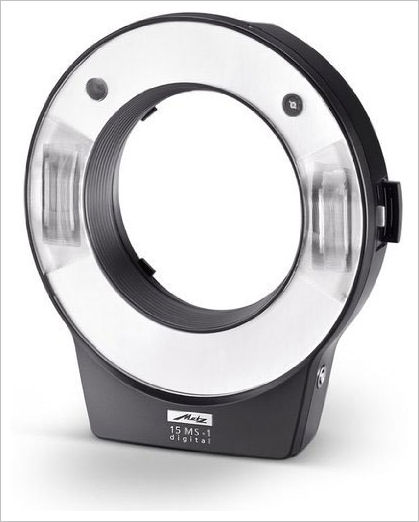
First let's deal with the name issue. Exactly what is this device. Vendors like to call it the "Metz Mecablitz 15 MS-1 Macro Ringlight Digital Flash", while Metz calls it the "mecablitz 15 MS-1 digital". There are two words that don't really belong here and they are "Ringlight" and "Digital". I don't quite know why the "digital" is there since the 15MS-1 is equally usable on film and digital cameras, but these days "digital" seems to be a term applied to everything from by to tripods. However the "Ringlight" term used by some vendors (but not by Metz) may be slightly misleading.
 The Metz Mecablitz 15 MS-1 is a flash system which mounts on the front of a lens via an adapter which screws into the filter threads on the lens. It's designed for macro photography (though it's also usable as a general purpose flash) and operates on the principle of getting the flash tubes close to the subject and providing uniform illumination. Since it surrounds the lens via a ring structure you might think that the tern "ringlight" would be appropriate, but it really isn't. The Metz Mecablitz 15 MS-1 has two small flash heads, one on either side of the ring. It lights the subject from both sides, not all sides. The tubes can be angled straight ahead, or independently angles inwards by 10 degrees or 20 degrees. There are similar looking systems (Such as the Canon MR-14EX TTL Macro Ring Lite Flash) which have a circular flash tube (or in the case of the Canon, two semi-circular flash tubes) which can provide light from all sides.
The Metz 15MS-1 is actually more similar optically to the Canon MT-24EX Macro Twin Lite which has two small flash heads which mount on opposite sides of the lens.
The Metz Mecablitz 15 MS-1 is a flash system which mounts on the front of a lens via an adapter which screws into the filter threads on the lens. It's designed for macro photography (though it's also usable as a general purpose flash) and operates on the principle of getting the flash tubes close to the subject and providing uniform illumination. Since it surrounds the lens via a ring structure you might think that the tern "ringlight" would be appropriate, but it really isn't. The Metz Mecablitz 15 MS-1 has two small flash heads, one on either side of the ring. It lights the subject from both sides, not all sides. The tubes can be angled straight ahead, or independently angles inwards by 10 degrees or 20 degrees. There are similar looking systems (Such as the Canon MR-14EX TTL Macro Ring Lite Flash) which have a circular flash tube (or in the case of the Canon, two semi-circular flash tubes) which can provide light from all sides.
The Metz 15MS-1 is actually more similar optically to the Canon MT-24EX Macro Twin Lite which has two small flash heads which mount on opposite sides of the lens.
In practice, for most purposes, it doesn't make a lot of difference whether the light has a circular flash tube has a single flash tube on either side of the lens. The circular tube tends to produce somewhat more uniform lighting with more diffuse shadows, but that's not always desirable as it's the shadows that give "depth" to any 3 dimensional object.
BTW, there are two types of ringlight. One is small, used primarily for macro work and often fits on the lens itself. The second is large (12-24" in diameter) and is used by portrait photographers for uniform lighting of headshots and ring like catchlights in the eyes (when the light is close to the subject). If that's what you are looking for then you need something more like the Diva Photo/Video Ring Light. A small ring flash, even a true ring design like the Canon MR-14EX will not give you those ring catchlights unless you are doing macro shots of the subject's eye. So as long as you don't get confused by the term "ringlight" we can now continue with the review...
Metz 15MS-1 Specifications
Guide Number: - 15m (49ft) ISO 100
Power: - 1, 1/2, 1/4, 1/8, 1/16, 1/32, 1/64
Left to Right (or Right to !eft) power ratios: - 1:1, 1:2, 1:4, 1:8 (-1, -2 or -3 stops)
Recycle Time: - 0.3-5 seconds
Lens adapters: - 52mm, 55mm, 58mm (supplied) plus 62mm, 67mm and 72mm (optional accessories)
Size: - 5.7 x 5.2 x 1.5" (145 x 132 x 38mm)
Weight: - 190gm (no batteries)
Batteries: - 2xAAA
Full power flashes per battery set: - 40 (alkaline); 200 (1000mAh NiMH); 250 (lithium)
Country of Origin: - The Metz 15MS-1 is made in Germany.
Metz 15MS-1 Operation
The 15MS-1 mounts on the front of a lens via an adapter which screws into the filter threads of the lens. Three adapters are supplied, for 52mm, 55mm and 58mm filter threads. Optional accessories are available for 62mm, 67mm and 72mm threads and cost around $20 each. The adapters are metal and "snap" into the main body of the flash unit.
Since there's a physical attachment between the front of the lens and the flash unit, Mets recommend only using the 15MS-1 with internal focusing lenses. There are obvious problems with any lens whose front element rotates during focusing and even with lenses which extend but don't rotate, the added weight of the 15MS-1 (190gm plus batteries) could cause problems by straining the autofocus mechanism.
The 15MS-1 is designed as a wireless optical slave unit which understands the TLL autoexposure flash protocols of Canon, Nikon, Olympus, Pentax, Samyang and Sony cameras which support wireless flash protocols. Once properly setup, the 15MS-1 provides fully TTL autoexposure with these systems. Some cameras have wireless master capability built into the camera via the popup flash (e.g. the Canon EOS 7D), while others may need a wireless master capable shoe mounted Speedlite of Flash controller (e.g. the Canon 60D or 5D MkII/III).
If the camera has no wireless flash protocol for TTL autoexposure there are two other methods by which the flash can be triggered. First a connection can be made using a standard PC flash cable between the 15MS-1 and the camera. When the flash is triggered this way, exposure is manual and the photographer has to set the shutter speed, aperture and ISO on the camera to get the desired exposure. However the flash power can be controlled manually too and settings of full, 1/2, 1/4, 1/8, 1/16, 1/32 and 1/64 power can be made using the control buttons and LCD on the 15MS-1 body.
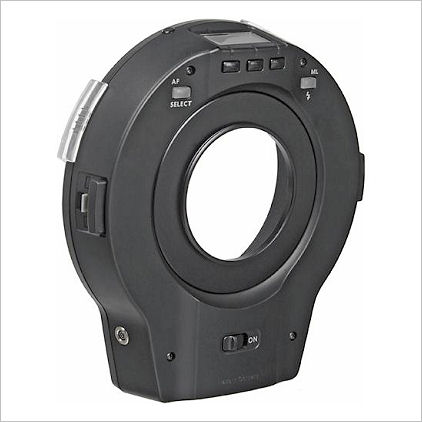
If the camera has no wireless flash protocol and no PC flash cord socket, then if it has any flash at all the 15MS-1 can be configured as a wireless slave. For cameras which emit a single flash, the MS15-1 will flash in synchrony with the camera flash. For cameras which emit one or more pre-flashes for metering or other purposes, the 15MS-1 has a learning mode. Since the main flash is always the last flash of any sequence, the MS15-1 can count the flashes on a test shot, then apply that information to subsequent shots so that it flashes at the right time, synchronously with the main camera flash.
In practice setting up the 15MS-1 for use with an EOS 7D was easy. By stepping through the menu, guided by the LCD on the 15MS-1 it's simply a matter of selecting "Canon", then selecting a wireless channel (Ch1) and then selecting a flash group (A). The EOS 7D was then set up for the popup flash to act as a wireless master controller on channel 1 for flash group A.
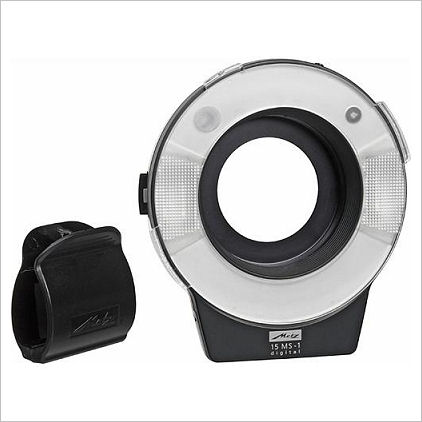
Visible Block, IR pass "clip on" filter shown on the left
Two forms of continuous light are available. There's an AF assist LED which lights up for 10 seconds when selected via a button and there's a mode which strobes the flash tubes rapidly for about 1 second when you want to check the lighting provided by the flash tubes.
Rear mounted lights on the 15MS-1 show when the flash is charged, if the last flash was too bright, too dim or OK.
The lighting ratio between the two flash tubes can be set via buttons and the LCD on the 15MS-1. Either side flash tube can be reduced by 1, 2 or 3 stops with respect to the other tube. This can be done in both manual and wireless TTL modes.
At distances closer than about 4", a clip on diffuser is supplied which both diffuses the light and lowers the intensity slightly. At very close distances the subject may be overexposed if the camera ISO is set too high and/or too wide an aperture is used. There's a minimum flash time for the tubes which sets the minimum amount of light they can give out.
Examples
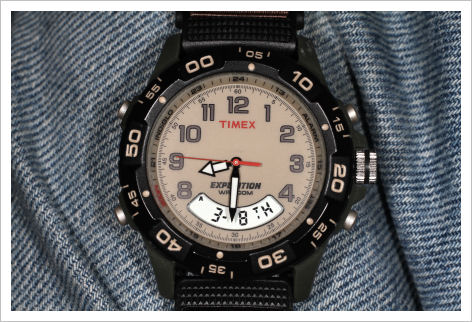
The first example shows a macro shot of a watch face with both left and right flash tubes firing. Note that there are two faint shadows. one on either side of the minute hand. If just the left tube is fired the result is as shown below:
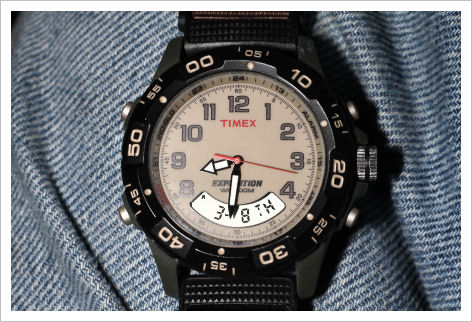
Note the more distinct shadow now seen to the right of the minute hand. Next is the result with just the right side tube firing:
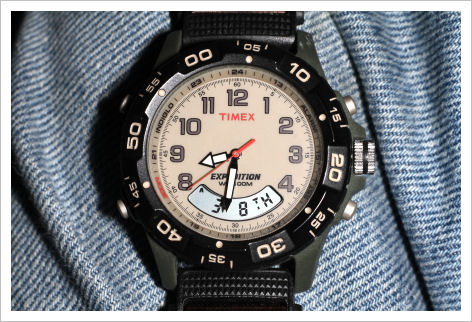
In this case the hard shadow now falls to the left of the minute hand. Various combinations of left and right flash tube powers can be selected to provide the desired lighting effect. With both tubes at the same power the result can sometimes look a little "flat".

Finally here's a flower macro shot. This flower was about 1/2" wide. Using the macro flash close to the subject allowed the use of an exposure which greatly underexposed the more distant background while providing the right exposure for the flower.
Conclusion
The Metz 15MS-1 does a good job and the wireless TTL capability makes autoexposure with a compatible Canon EOS system very easy. The same should apply for Nikon, Olympus, Pentax, Samsung and Sony systems. The versatility of the 15MS-1 would be a great help to anyone using multiple camera systems and the camera manufacturers flash units normally only work with their own cameras. If at some future time any of the wireless protocols changes, or a new system appears, the 15MS-1 has a USB port via which the firmware can be updated, ensuring future compatibility.
The Metz 15MS-1 makes macro photography easy and it's especially useful for outdoor nature macro work where there's often not time to setup and adjust lighting. Insects don't hang around long and the ability to get in there and rapidly obtain a sequence of well exposed shots under pretty much any ambient lighting condition (sunny, cloudy, day or night) is invaluable.
For indoor studio work you could probably get similar results to those from the Metz 15MS-1 using multiple individual flash units perhaps in combination with a diffusion tent, but the Metz 15MS-1 makes everything quicker and easier.
Alternatives
While the 15MS-1 isn't cheap at around $399, it's cheaper than either the Canon MR-14EX TTL Macro Ring Lite at around $520 or the Canon MT-24EX Macro Twin Lite at around $780.If you want something similar to the Metz 15MS-1 which provides E-TTL autoexposure but uses a wired connection rather than wireless, the Sigma EM-140 DG Macro Ring Flash is very similar, with similar functions and even has a similar (but slightly lower) price! The advantage would be that a wireless speedlite controller on the camera would not be needed, so it could be used directly on any EOS body by attaching it to the camera's hot-shoe.
There are also numerous LED based "ring lights" (e.g. Polaroid Macro Ring Light), but these belong in a different class. They're essentially low power continuous lighting (even if they are "flashed" on and off), and have much lower power than flash units like the Metz 15MS-1. They requires higher ISO settings and/or larger apertures as well as longer exposure times. A flash unit like the Metx 15MS-1 can freeze motion since the duration of the light pulse is measured in fractions of a thousandth of a second. LED based lights will typically provide shutter speeds of longer than 1/100s, sometimes slow enough that motion blur due to camera or subject movement can spoil the image.
